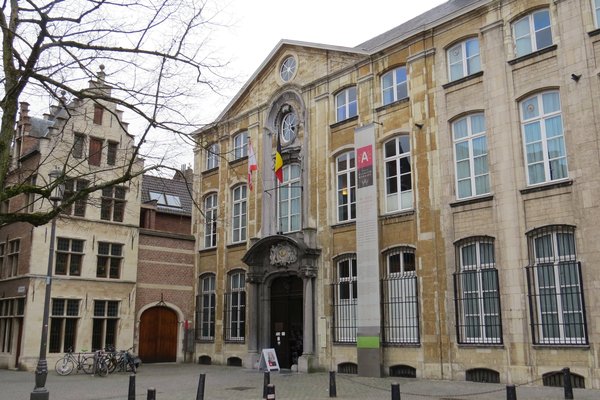Belgium
Plantin-Moretus Museum
The Plantin-Moretus Museum is linked with the spreading of ideas of European humanism via its printing business Officina Plantiniana.
The museum is housed in the former residence and printing business of famous printers Christoffel Plantijn and Jan Moretus. They had a successful printing workshop and publishing house in the late 16th century, printing humanist and scientific publications. The workshop, its furnishings and the immaterial heritage associated with the business have been preserved in the original location.
Community Perspective: Everyone seems to like this one, and you can easily spend two hours inside drooling over the typographical matrices, the globes, the Gutenberg Bible and the Rubens paintings.
Site Info
Official Information
- Full Name
- Plantin-Moretus House-Workshops-Museum Complex (ID: 1185)
- Country
- Belgium
- Status
-
Inscribed 2005
Site history
History of Plantin-Moretus Museum
- 2005: Inscribed
- Inscribed
- Type
- Cultural
- Criteria
- ii
- iii
- iv
- vi
Links
- UNESCO
- whc.unesco.org
- Official
-
- museumplantinmoretus.be — Museum Plantin-Moretus
All Links
UNESCO.org
- whc.unesco.org — whc.unesco.org/
Official Website
- museumplantinmoretus.be — Museum Plantin-Moretus
News Article
- June 21, 2018 vrt.be — 450 year old Biblia Polyglotta on show at Museum Plantin-Moretus
- Sept. 28, 2016 deredactie.be — Plantin-Moretus Museum reopens after refurbishment
- March 9, 2016 gva.be — Plantin-Moretus Museum to close May-Sept 2016for refurbishment
Community Information
- Community Category
- Secular structure: Science and Education
Travel Information
Recent Connections
-
Name changes
Upon inscription, from Plantin-Moretus …
-
No Map
-
Named after individual people
Christoffel Plantin and his son-in-law,…
Connections of Plantin-Moretus Museum
- Individual People
-
-
Peter Paul Rubens
He was a friend of the family and made several paintings/bookcovers for them
-
- Geography
-
-
Scheldt
In Antwerp, some 300m from the Scheldt
-
- Trivia
-
-
WHS within walking distance
Antwerp
-
- Architecture
-
-
Baroque
"Criterion (iv): As an outstanding example of the relationship between the living environment of a family during the 16th, 17th and 18th centuries, the world of work and the world of commerce, the Plantin-Moretus Complex is of unrivalled documentary value relating to significant periods of European history: the Renaissance, the Baroque and Classicism. (Official description) -
Brick architecture
-
- Damaged
-
-
Damaged in World War II
damaged in 1944 bij a german V2-rocket
-
- World Heritage Process
-
-
Single Monuments
-
No Map
-
First sites filling gaps cited by ICOMOS
non mining pre Industrial revolutions technological properties in Europe 2005
-
Perfect Inscriptions
2005
-
- WHS on Other Lists
-
-
Memory of the World
Business Archives of the Officina Plantiniana (2001) (Plantin-Moretus Museum) -
European Capital of Culture
Antwerp, 1993
-
- Timeline
-
-
Built in the 16th century
Christoffel Plantin set himself up as a printer in 1555, founding his publishing house 'De Gulden Passer' (The Golden Compasses). In 1576 he moved his printing business to the Vrijdagmarkt square.
-
- WHS Hotspots
- Science and Technology
- WHS Names
-
-
Named after individual people
Christoffel Plantin and his son-in-law, Jan Moretus, both printers -
Name changes
Upon inscription, from Plantin-Moretus Museum to Plantin-Moretus House-Workshops-Museum Complex
-
News
- vrt.be 06/21/2018
- 450 year old Biblia Polyglotta on …
- deredactie.be 09/28/2016
- Plantin-Moretus Museum reopens aft…
- gva.be 03/09/2016
- Plantin-Moretus Museum to close Ma…
Recent Visitors
Visitors of Plantin-Moretus Museum
- AC
- Adrian
- Adrian Turtschi
- Afshin Iranpour
- Alexander Barabanov
- Alexander Lehmann
- Alexander Parsons
- Alex Goh
- A. Mehmet Haksever
- Ana
- Angela Vandyck
- Argo
- Ask Gudmundsen
- Aspasia
- Assif
- Astraftis
- a.thum
- Atila Ege
- basementonline
- BaziFettehenne
- BeyondMonkey
- Bill Maurmann
- Bin
- BobSmithseestheworld
- Bram de Bruin
- brendairala
- Brendan Carroll
- Can SARICA
- Caspar
- Cezar Grozavu
- Chantal den Haan
- chenboada
- ChrisDorn
- Christer Sundberg
- Christine
- christof
- Christoph
- Christravelblog
- Claire Bradshaw
- Cluckily
- Clyde
- Colossus
- Coppi
- Corinne Vail
- Cristina Erba
- Csaba Nováczky
- ctravel
- cwthong
- Damientournay
- Dani Cyr
- Daniela Hohmann
- Daniel Chazad
- David Aaronson
- David Berlanda
- Deffra
- Digits
- Dimitar Krastev
- Dimitrios Polychronopoulos
- Dirk-pieter
- DL
- Don Irwin
- Dorejd
- Doubanjiang
- Dr. Caligari
- Dwight Zehuan Xiao
- Echwel
- Elaine McArdle
- Elis
- Els Slots
- emvcaest
- Engielle
- erdsaumnaht
- Erik Jelinek
- Errol Neo
- Eva Kisgyorgy
- fabi-ddorf
- Fan Yibo
- Farinelli
- Federico P.
- Feldhase
- Femke Roos
- Flexiear
- FrankW
- Frederik Dawson
- FS
- Gabbro
- Gary Arndt
- Geert Luiken
- George Gdanski
- GeorgeIng61
- Hadrianus
- Hammeel
- Harald T.
- Harry Mitsidis
- henrik_hannfors
- heywhatever2
- Hubert
- Hughes1920
- Hurrvinek
- Iain Jackson
- Ian Cade
- Ingemar Eriksson
- Ingrid
- Ivan
- Ivan Rucek
- Jacob Choi
- Jakob F.
- Jakubmarin
- James Bowyer
- Jana and Matt
- Janina Lehmann
- janis
- Jan-Willem
- Jan Zimmermann
- Jarek Pokrzywnicki
- Jasam
- Jay T
- Jean Lecaillon
- Jeanne OGrady
- Jeffrey Chai
- Jens
- Jesse S 2010
- JessicaDS
- Jezza
- J_neveryes
- João Aender
- Joel on the Road
- John Smaranda
- Jonas Kremer
- jonathanfr
- Jon Bauer
- Jon Eshuijs
- jonstst
- Joyce van Soest
- Jurre
- jxrocky
- KarenBMoore
- Karito Vies
- Kasia M.
- Kbecq
- Ken DJ
- Klaus Freisinger
- Knut
- Krijn
- Kristin
- Kurt Lauer
- Lado Joel
- Lara Adler
- Laurey
- Linneaaasaurus
- Lisu Marian
- Loic Pedras
- Luboang
- Lucio
- lucyannesmith
- Ludvan
- Luis Filipe Gaspar
- Lukasz Palczewski
- lynnz317@aol.com
- Maciej Gil
- Maciej Gowin
- Mahuhe
- Manuelfunk
- marcel staron
- Marlies van Wolfswinkel
- Martin
- Martina Rúčková
- Matejicek
- Mathijs
- MaxHeAnouBen
- MaYumin
- MH
- M. Huineman
- MichaelH
- Michael Novins
- Michael Turtle
- Mihai Dascalu
- Mikko
- Mikko Syrjä
- Miloš Tašković
- Mohboh
- Mstrebl1990
- nan
- Nasebaer
- Nick M
- Nicole Lampos
- Nihal Ege
- NoahFranc
- Olli-Pekka Turunen
- Patrik
- Paul Schofield
- PeterH
- Peter Lööv
- Petteri
- Philipp Leu
- Philipp Peterer
- Pieter Dijkshoorn
- PlacesWeHaveBeenTo
- Porcho
- Potsdamer
- Purrfect
- Rafał Kałczuga
- Ralf Regele
- Randi Thomsen
- Reisedachs
- Reza
- Riccardo Quaranta
- Rick Ohm
- RobRos
- Roel Sterken
- Roger Ourset
- Roman Bruehwiler
- Roman Raab
- Rudegirl
- Sabrina Liebehentschel
- Samy G
- Sandra!
- S. Anril Tiatco
- Sebasfhb
- Sergio Arjona
- Shandos Cleaver
- shoaibmnagi
- Simonf
- SirLoydd
- Slavi
- Solivagant
- Spike Zou
- Ssong.x
- Stanislaw Warwas
- stephanvermeulen
- Stijn
- Svein Elias
- Szucs Tamas
- takanenohana
- Tamara Ratz
- Taotao Chen
- Tarquinio_Superbo
- Tatiana Nikulnikova
- Tevity
- Thomas Buechler
- Thomas Harold Watson
- Thomas van der Walt
- Thorben
- tingmelvin
- tommasorossotti
- Tonisan
- tony0001
- Tony H.
- triath
- Tsunami
- usagi1974
- ValiaVeweth
- Vanessa Buechler
- Viaje al Patrimonio
- Vincent Cheung
- VLabhard
- WalGra
- Walter
- WILLIAM RICH
- Wojciech Fedoruk
- wrung24
- Xander Huang
- Xiquinho Silva
- YaroMir
- Yevhen Ivanovych
- Zhenjun Liu
- Zoë Sheng
- Zos M
Community Reviews
Show full reviews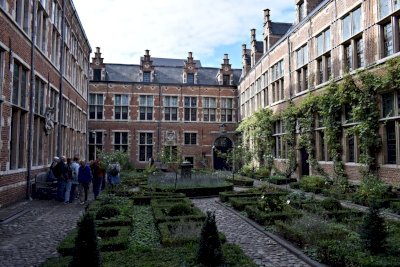
I arrived into Antwerp from Brussels on the train and was immediately in love with the station. Ascending from the underground through platforms on enormous escalators into the cavernous space above was like entering a cathedral devoted to the railways. I was able to stash my larger bags into the automated lockers, although most of these were already full by the time I got there at about 9:30 am so being early is probably required to guarantee one, before setting out to explore the city. Antwerp is full of grand buildings dating back to its golden age in the 16th Century as one of the premier ports of Europe in the early days of colonialism. I particularly like the Grote Markt square, which is not too far behind Brussel’s Grand Place in my estimation. Indeed, it seems to me the ‘Historic Centre of Antwerp’ would have easily been a World Heritage Site in its own right if nominated early on. However, the Belgians may well have left it too late as there are now so many (arguably too many) sites of that type in Europe that something spectacular would be needed to squeeze in and Antwerp, as marvellous as it is, might just fall short.
In any case, Antwerp already has a WHS in the form of the Plantin-Moretus House-Workshops-Museum Complex. This is a disproportionately long name for what must be one of the smallest WHS, comprising just a single 16th Century building. Having walked around Antwerp all morning, …
Keep reading 0 comments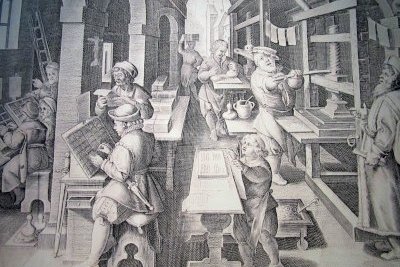
The United States celebrates National Library Week each April, but libraries in the US and around the world would be in poor shape were it not for publishing houses and the printed word; hence, the Plantin-Moretus Museum in Antwerp, Belgium, finds its place on the World Heritage Site list. I had high expectations for the museum when I visited last August, and the audio tour I took easily met those expectations. The Plantin-Moretus Museum showcases a 16th century publishing house run as a family business. While walking through the house, guests have the opportunity to view and learn about the library, typesets and printing presses (including the two oldest printing presses in the world), and famous works the family had printed, including the Biblia Polyglotta and an atlas by fellow Antwerpenaar Abraham Ortelius. I was particularly amused to learn that Times New Roman, a font I use often when writing, is based on a typeface designed by the Plantin Press. In addition to printing books, the presses also were used for illustrations and drawings, including a fantastic piece showing what the business looked like 400 years ago. I highly recommend this site to anyone visiting Belgium.
Logistics: The Plantin-Moretus Museum is a short walk away from central Antwerp.
Keep reading 0 comments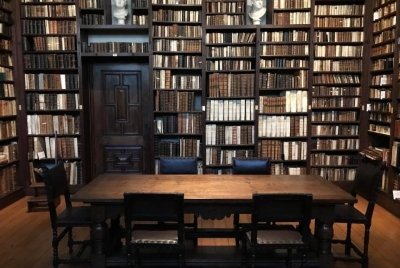
Johannes Gutenberg’s movable-type was quicker than the traditional woodblock printing. This paved the way for the rapid printing of the bible (“Gutenberg Bible”) which eventually placed the movable-type as an important “invention” in the early modern European period. The printing press even assisted Martin Luther in the quick dissemination of the infamous “Ninety-five Theses” or “Disputation on the Power of Indulgences” which shook the authority of the Catholic Church. Eventually, the technology of the press rapidly spread in the European continent. One of the figures who was influenced by Gutenberg’s invention was Christophe Plantin.
Plantin’s printing company was founded in the 16th century. The workshop (printing press) was established in his house in Antwerp, Belgium. During his time, Plantin was considered a major figure in printing, especially since he was constantly printing manuscripts in the humanities.
Today, the once-upon-a-time workshop house and mansion is now a museum. The 16th century-printing technology and system is still functional. Once in a while, some documents/manuscripts are still being printed through the movable type. Now known as the Plantin-Moretus House-Workshops-Museum Complex, it is a UNESCO World Heritage Site, nominated by City of Antwerp in 2002 and finally inscribed in 2005.
The museum was excellently curated. Entering from the first section ("the house") to the workshop itself was a walk back in the early modern era - the decorations, the arrangements of the furniture and the ambiance.
The museum houses a massive and impressive collection of 16th to 19th century printed …
Keep reading 0 comments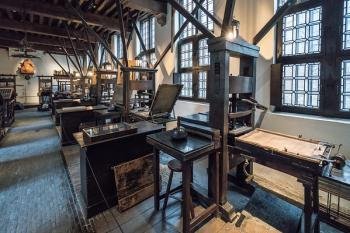
I visited here in January of 2017.
The Plantin-Moretus House was more interesting than I thought it would be. What made is so interesting is that a single family lived in the same house for several centuries, running a printing business in the same facility. Because of the continuity, they preserved some of the oldest printing presses and printing material in the world.
The house also contains several original paintings by Rubens, which you would otherwise have to go to an art museum to see.
The site is located in the heart of Antwerp and is easy walking distance from the Cathedral and other attractions.
Read more about the Plantin-Moretus House-Workshops-Museum Complex on my website.
Keep reading 0 comments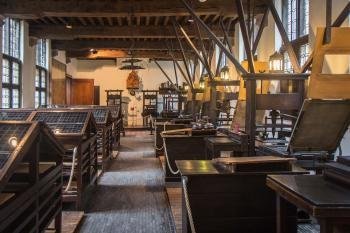
When you visit the Platin-Moretus Museum, there are a few different elements to explore. The first is the building itself, which is architecturally significant. Inside, you’ll also find the living quarters of the family – grand rooms filled with collectables and less lavish areas for the staff.
It’s worth taking note of a small room on one side of the house which looks like a quaint old bookstore. In fact, it is, and the company sold books from here directly to people on the street.
A highlight is stepping into the Great Library. This was designed like a private humanist library of the 17th century with busts, globes and paintings decorating the areas not taken up with books. Although the collection of books here has been expanded since the library was created, it’s still an authentic representation.
Keep reading 0 comments
This museum is really a hidden treasure that the crowds that flock to Antwerp's cathedral and market square, which are really just a few steps away, often overlook. It has been described in detail on this page already, and I can certainly say that it would be a big mistake to leave this great city without visiting the Plantin-Moretus Museum and learn more about printing, books, atlases, libraries, history, philosophy, geography - the beginning of the modern world, really. On a side note, just around the corner (almost) is the entrance to the St. Anna Tunnel, where pedestrians and cyclists can cross the Schelde River underwater to admire the city's skyline from the opposite bank.
Keep reading 0 comments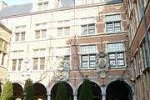
I had visited Antwerp twice and didn't know that this WHS museum was there! It is really interesting and well worth a visit although quite expensive.
Keep reading 0 comments
I strongly agree with Ian. I visited the museum this April and loved it. Incomprehensible why in some Antwerp travel guides the museum isn’t even mentioned as a highlight. The museum is definitely a must to see in Belgium. It’s really easy to reach, as it’s in the centre of Antwerp, a few minutes walking distance from the main square. I think everything about the museum is already told by Ian. I just can ad that apart from the museum, Antwerp itself is well worth a visit (the small Belfry is also Unesco listed). The main square can compete with those from Bruges or Brussels, there is a gigantic cathedral and the train station is more kind of a palace. Further it seems that there is a restaurant for every kitchen of this planet. If you go to Belgium it would be a big mistake not to visit Antwerp and the Plantin-Moretus Museum.
Keep reading 0 comments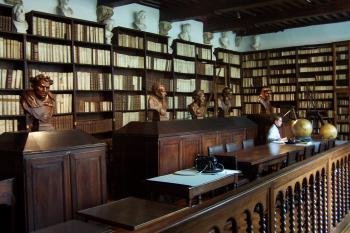
This is a truly fantastic site, sometimes I wonder about the merits of later and more esoteric additions to the list; however this place fully warrants its inclusion.
The building itself is pretty impressive and the level of decoration throughout is striking, especially the guilt leather wall coverings. The courtyard is also very nice and many of the rooms look out onto it.
The exhibits themselves are world class, notable are; the two oldest printing presses in the world, original works of many important Humanist philosophers (of whom Justus Lipsius once worked in the house), masses of typographical matrices including originals by Garamond (it is almost certainly in your font collection on your computer still), many book decorations by family friend Rubens with their original printing plates and a 36 line Gutenberg Bible! On top of this are the entire accounts of the Officina Plantiniana starting from 1555, which are included on the UNESCO Memory of the World list in their own right. There is so much more but not enough time to list all on display.
The highlight for me was the Geographical room featuring several globes masses of maps and what is regarded as the first printed Atlas.
The thing that makes this such a special site; and a main reason ICOMOS sighted for its inclusion, is that it is all in situ. These were where most of the items displayed were conceived/ created/ printed, all in Antwerp which was a key centre of early printing.
The free …
Keep reading 0 comments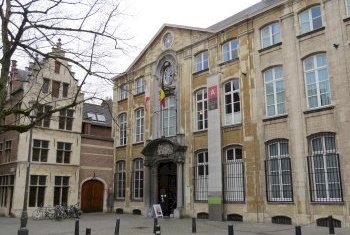
This museum is located in a patrician's house on a quiet square in the center of Antwerp. It really shouldn't be missed by anybody interested in history (or WHS). There's much more to see and tell than can be said on this one page.
The whole museum is excellent. I spent about two hours there doing the rounds with an audioguide. Its special attractions are threefold: a great building with period furniture, the introduction to the 16th and 17th-century printing business and the priceless collection of books and prints. The Plantin-Moretus family was very wealthy and collected many original pieces (like a Gutenberg Bible).
There are about 30 rooms you can enter, ranging from libraries to the family bedroom. The craftsmanship of the printing industry is detailed in a video. After that, you can amaze yourself at the collection of materials and instruments that is still there and looks like it could be working again any minute. They were printing in French, Greek, Latin, Hebrew and even Ethiopian. Mistakes were spotted by editors and then corrected before the final prints were made.
Keep reading 0 comments
